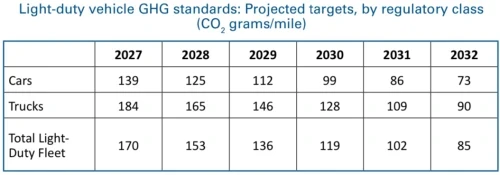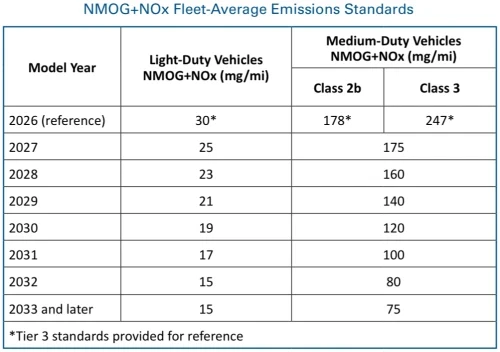EPA announced a final rule, Multi-Pollutant Emissions Standards for Model Years 2027 and Later Light-Duty and Medium-Duty Vehicles, that sets new, more protective standards to further reduce air pollutant emissions from light-duty and medium-duty vehicles starting with model year 2027.
The final standards will significantly reduce emissions of greenhouse gases (GHG), hydrocarbons, nitrogen oxides (NOx), and particulate matter (PM) from new passenger cars, light trucks, and larger pickups and vans.
The final rule builds upon EPA’s final standards for federal greenhouse gas emissions standards for passenger cars and light trucks for model years 2023 through 2026. These standards will phase in over model years 2027 through 2032.
The standards are technology neutral. EPA projects that from MYs 2030-2032 manufacturers may choose to produce battery-electric vehicles (BEVs) for about 30% to 56% of new light-duty vehicle sales and about 20% to 32% of new medium-duty vehicle sales. EPA also projects that consumers will see an increase in the availability of other clean vehicle technologies, including hybrid electric vehicles and plug-in hybrid electric vehicles, as well as cleaner gasoline vehicles.
Greenhouse gas standards. For light-duty vehicles, the greenhouse gas standards are projected to result in an industry-wide average target for the light-duty fleet of 85 grams/mile (g/mile) of CO2 in MY 2032, representing a nearly 50% reduction in projected fleet average emissions target levels relative to the existing MY 2026 standards.

For medium-duty vehicles, EPA is revising the existing standards for MY 2027 and establishing new standards for MYs 2028-2032, given the increased feasibility of GHG emissions-reducing technologies in this sector in this time frame. These standards phase in over a six-year period from MY 2027 through MY 2032. When fully phased in, the MDV standards are projected to result in an average target of 274 g/mile of CO2 by MY 2032, representing a 44% reduction in projected fleet average emissions target levels relative to the existing MY 2026 standards.
Criteria pollutant emissions standards. With the rule, EPA is finalizing Tier 4 criteria pollutant emissions standards for non-methane organic gases (NMOG), NOx, PM, and other criteria pollutants and their precursors. For light-duty vehicles, EPA is finalizing NMOG plus NOx standards that will phase down to a fleet average level of 15 milligrams per mile (mg/mi) by MY 2032, representing a 50% reduction from the existing 30 mg/mi standards for MY 2025 established in the Tier 3 rule in 2014.
For MDVs, EPA is finalizing NMOG+NOx standards that will require a fleet average level of 75 mg/mi by MY 2033, representing a 58% to 70% reduction from the Tier 3 standards of 178 mg/mi for Class 2b vehicles and 247 mg/mi for Class 3 vehicles. The standards will also reduce emissions of mobile source air toxics.

The NMOG+NOx standards continue the emissions certification “bin” structure approach EPA has used in prior programs. Under this structure, manufacturers assign each vehicle model to a bin that includes the applicable NMOG+NOx standards. The standards both add more bin resolution at low-emission bins to give manufacturers added flexibility and eliminate the highest certification bins to disallow production of the highest-emitting vehicles. EPA is requiring manufacturers to meet the standards across four driving cycles to ensure robust emissions control over a wide range of in-use driving conditions.
For both light-duty and medium-duty vehicles, EPA is finalizing a PM standard of 0.5 mg/mi and a requirement that the standard be met across three test cycles, including a cold temperature (-7 °C) test. The PM standard is a per-vehicle cap (not a fleet average) and will be fully phased in by MY 2030 for light-duty vehicles and by MY 2031 for medium-duty vehicles. EPA projects the PM standard will reduce tailpipe PM emissions from gasoline vehicles by more than 95% in addition to reducing mobile source air toxics.
EPA is finalizing cold temperature (-7 °C) NMOG+NOx standards for light-duty vehicles and MDVs to ensure robust emissions control over a broad range of operating conditions. EPA is finalizing three provisions aligned with the California Air Resources Board (CARB) Advanced Clean Cars II (ACC II) program for addressing light-duty vehicle NMOG+NOx emissions from frequently encountered vehicle operating conditions not previously captured in EPA test procedures: (1) high power cold starts in plug-in hybrid electric vehicles; (2) early drive-away; and (3) mid-temperature engine starts. EPA is also finalizing standards aligned with the CARB ACC II program that address high load emissions from medium-duty vehicles with high gross combination weight rating (GCWR).
To provide manufacturers with additional time to adjust product plans and apply technologies to vehicles, EPA is finalizing gradual phase-ins for criteria pollutant standards. For light-duty vehicles greater than 6000 pounds GVWR and medium-duty vehicles, manufacturers have the choice of either the default phase-in or an optional incentivized early phase-in schedule.
The vehicle technology costs of this program are estimated at $40 billion annualized value. EPA says the program will have additional social benefits from fuel savings of $46 billion annualized value, and repair and maintenance savings of $16 billion annualized value.
EPA estimates that the standards will increase the per-vehicle technology costs to auto manufacturers by about $1,200 for light-duty vehicles and $1,400 for medium-duty vehicles over the six-year average from MY 2027-2032.
Source from Green Car Congress
Disclaimer: The information set forth above is provided by greencarcongress.com independently of Chovm.com. Chovm.com makes no representation and warranties as to the quality and reliability of the seller and products.




